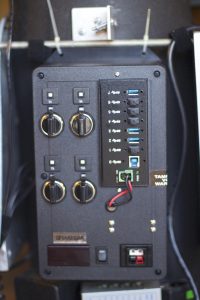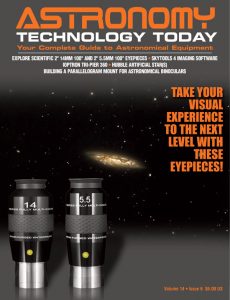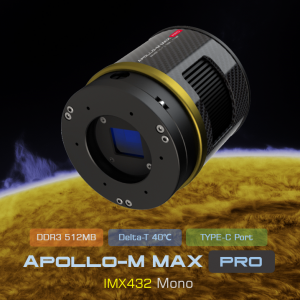Kendrick Imaging Power Panel Review

Kendrick Astro Instruments, out of Toronto, is a name that many avid amateur astronomers have known for years. I became familiar with them through their telescope dew-removal systems, several types of which I have owned over the years. Recently, they have developed several variations of power-distribution panels to meet a multitude of astronomical needs. In this article, I will cover their Imaging Power Panel.
Image 1 shows the Kendrick Imaging Power Panel model 208-IPP-C-3.0 right out of the box. There are essentially five regions on the panel to point out. On the left side there are four standard automobile-type 12-volt outlets with covers. The top two are 5-amp while the bottom two are 7-amp and 10-amp. You can special order to have one of these outlets set to 15-, 18-, 24- or 48-volts – useful if you own a mount or camera that uses a higher voltage.
On the upper-right side of the power panel are eight USB 3.0 ports. The top seven ports, numbered 1-7 (upside down), are powered and used for plugging in CCD or DSL cameras, autofocus controllers, telescope controllers, or any other equipment with a USB connection. All seven ports come with covers. As you can see in Image 1, I have removed the covers on three of the ports. The eighth port, numbered 0, is a USB Standard B jack. That’s where you connect the supplied 6-foot USB cable to a computer. Finally, three items are arranged left to right across the bottom: a red digital display window showing the power drawn, the on/off switch and the Anderson-type jack where the external power plugs into the unit.
The Imaging Power Panel can be used in a permanent observatory, where AC power is available, or at remote sites using a 12-volt battery. Image 2 shows the power supply and cables I ordered with my power panel. On the left (black) is a 15-amp AC-to-12-volt DC power supply. The gray cable converts the mini-DIN connector on the power supply to the Anderson plug to fit into the power panel. Since the AC power supply is 15-amp, yet the power panel has four 12-volt outlets rated for a total of 27 amps, the power panel cannot deliver more than 15 amps. Actually, the output will be less than this due to electrical losses. But when you think about it, 15 amps is a lot of current and should easily be enough for most observatory systems!
Finally, the red and black cable in Image 2 is for connecting a 12-volt battery directly to the Imaging Power Panel. One end of this cable contains the Anderson plug for connecting to the power panel, while the other end has standard 12-volt terminal rings (I am sorry they are not clearly visible in the image). You can order this cable from Kendrick instead with terminal clips

or with a 12-volt automobile-type plug instead of terminal rings.
I installed the Kendrick Imaging Power Panel in my observatory as shown in Image 3. The bottom of the pier already had the aluminum plates held together with long threaded rods for holding previously installed equipment. All I had to do was pass two zip ties through the top two mounting holes on the Power Panel to hold it in place!
Prior to installing the Power Panel, I had myriad cords extending away from the telescope pier, looking like a wild mess of wire spaghetti. Now I only have two cords leaving the pier: a single USB cord connecting the desktop computer and a 110-volt AC power cord. I have three USB items plugged into the Kendrick Imaging Power Panel: two CCD cameras and the USB-to-serial adapter for controlling my telescope mount. Three 12-volt power plugs power two CCD cameras and the telescope fans. Depending on what telescope I am using on the mount, I also power mirror cooling fans from the Kendrick panel.
Whether used in a permanent observatory or setting up a telescope at a dark site for a single night of astronomical imaging, the Kendrick Imaging Power Panel provides an easy way to simplify the power needs for telescopes, cameras and a plethora

of astronomical accessories. The ability to order the panel with custom features and cables adds to the versatility of power distribution. Kendrick definitely has another winner with this product.
While this article covers the Kendrick Model 208-IPP-C-3.0 Imaging Power Panel, where the “C” designates that the panel is specifically configured for powering CCD cameras, the Kendrick IPP is also available configured for powering DSLRs. The later carries a “D” designation.
“3.0” denotes that the Model 208-IPP-C-3.0 covered in this article features USB 3.0 hub. Both “C” and “D” IPP versions are also available with a USB 2.0 hub instead of USB 3.0. Those versions are simply designated as Model 208-IPP-C or Model 208-IPP-D.
IPPs are also available with 15-, 18, 24- or 48-volt inverters preinstalled to accommodate, for example, Astro-Physics, Losmandy, Takahashi or Bisque mounts, respectively. The voltage delivered by these inverters is smooth, unaffected by voltage cycling caused by varying power demands. All four outlets are protected by circuit breakers, regardless of the voltage for which each individual outlet is configured, eliminating the need of spare fuses.
The Kendrick Imaging Power Panel Model 208-IPP-C-3.0 IPP weighs 2.8 pounds (1.3 kilograms) and measures 11.375 by 6.125 by 3.75 inches (290 by 155 by 95 millimeters). The USB 2.0 version weighs 2.7 pounds (1.1 kilograms) and measures 9.375 by 6.125 by 3.25 inches (235 by 127 by 83 millimeters).
By Dr. James Dire. Dr. Dire has an M.S. degree in physics from the University of Central Florida and M.A. and Ph.D. degrees from The Johns Hopkins University, both in planetary science. He has been a professor of physics astronomy at several colleges and universities. He is the president of Methodist College in Peoria, Illinois. He has played a key role in several observatory projects including the Powell Observatory in Louisburg, KS, which houses a 30-inch (0.75-m) Newtonian; the Naval Academy observatory with an 8-inch (0.20-m) Alvin Clark refractor; and he built the Coast Guard Academy Astronomical Observatory in Stonington, CT, which houses a 20-inch (0.51-m) Ritchey Chrétien Cassegrain.
###
 And to make it easier for you to get the most extensive telescope and amateur astronomy related news, articles and reviews that are only available in the magazine pages of Astronomy Technology Today, we are offering a 1 year subscription for only $6! Or, for an even better deal, we are offering 2 years for only $9. Click here to get these deals which only will be available for a very limited time. You can also check out a free sample issue here.
And to make it easier for you to get the most extensive telescope and amateur astronomy related news, articles and reviews that are only available in the magazine pages of Astronomy Technology Today, we are offering a 1 year subscription for only $6! Or, for an even better deal, we are offering 2 years for only $9. Click here to get these deals which only will be available for a very limited time. You can also check out a free sample issue here.



